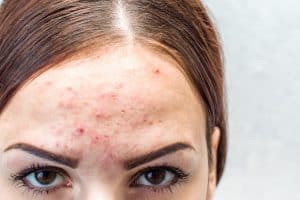What are Blackheads?
Blackheads are caused by clogged hair follicles. This Hair follicles can be clogged with Dirt, Sebum, or other Debris. They are a form of Acne, however, they appear black or dark on the surfaces, and are hence known as Blackheads. (1)
They are also commonly called as comedones. Comedones are caused by trapped hair follicles. This can be due to excessive oil secretion, along with clogging due to dead skin cells, other debris such as Keratin found in the hair. Usually, there is an excessive release of oils by your skin when you’re a teenager and your hormones are all over the place. That’s when your skin remains oily and your pores get clogged up.(2)
The causal factors can be the following :
-
Hormonal Imbalance
-
Thyroid problems
-
Genetics
-
Skin care products
That being said, Comedones can be seen in any age group. Most women go through certain milestones in their life which causes fluctuations in their hormones.
These fluctuations can also happen when you have a thyroid problem. The thyroid is responsible for your metabolism and also helps in regulating your hormones.
It’s also seen that there can be a genetic factor to this, if your parents are prone to comedones then you can be too. This applies to Acne and most of the other skin conditions as well.
Although in certain cases this can be a result of the products that you use on your skin.
There are certain elements in the products that you use that cause your skin to remain oily and retain moisture. This could result in causing more comedones because it’s going to add to the oil trapped in your pores.
For example, there are certain products such as Vitamin E oil and cocoa butter that don’t so well for your skin in case its oily. That’s why it’s better to go for non- comedogenic products for your skin.
Why do they occur on the nose?
Blackheads are not restricted to the face, they can also appear on the back, legs, hands etc. But they are most commonly seen on the nose, this is due to the open pores and a larger number of active sebaceous glands around the nose region.
Blackheads might also be due to hormonal imbalance that increase the oil production in your skin, and also due to increased humidity in the weather.
Blackheads end up being black because the sebum in the pores contains some amount of melanin, and when this melanin gets oxidized, it turns dark and eventually black. (2)
Even though Blackheads are a mild form of pimples, they generally don’t hurt unless meddled with. If a Blackhead is growing in Size then it’s generally better to consult a physician.
Things not to do when you have blackheads:
If you’re thinking of using a blackhead remover, it’s better to get a professional to help you with this. You might press the metal part too hard on your skin, causing it to leave a mark after.
Keep your nails off, don’t try to pick your blackheads because this might leave a hole or dent, which doesn’t solve the problem of it being an open pore. This only means that chances are a blackhead will pop up again in the same place if you don’t take the right care.
Don’t over wash or scrub, just because scrubbing helps in removal don’t over do it to such an extent that your skin dries out. To establish a balance your skin will secrete excess oil, which could result in more conditions including more blackheads.
Prevention is always better than cure, and all you have to do to prevent blackheads is to scrub your face regularly with gentle exfoliators. You can use oatmeal mixed with honey or milk and work it in circular motions on your skin.
Wash your face twice a day so that oil and dead skin cells aren’t allowed to settle into pores.
How to get rid of Blackheads?
- Use a scrub – Like I mentioned before, it can be homemade like an oatmeal scrub, or even sugar used as a scrub can help.
- Peel offs – Chemical peels that contain Salicylic Acid, glycolic acid can help in removal. If not chemical peels, you can use honey. Let honey rest on your nose for 15-20 minutes, after which you can peel it off. (3)
- Steaming – You can do a steaming facial at home. Followed by a scrub or a wash, at least twice a week. Steaming opens up your pores and lets out all the clogged sebum and dirt. Although, this treatment might not agree with everyone. (4)
- Blackhead remover – You can opt for this option only if you have professional who is doing this procedure for you. Otherwise, you could be at the risk of having a scar or mark left behind.
Struggling with a Skin or Hair issue? Download the CureSkin App now by clicking here to get the best treatment. It’s easy, fast and affordable!





